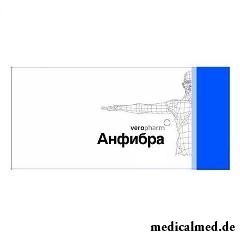





Anfibra
Application instruction:
 Anfibra – anticoagulating drug.
Anfibra – anticoagulating drug.
Form of release and structure
Dosage form of release of Anfibra – solution for injections: transparent, with a yellowish shade or colourless (in ampoules on 0,2, 0,4, 0,6, 0,8 or 1 ml, in a cardboard pack 2, 5, 10 ampoules complete with an ampoule knife; in syringes on 0,2, 0,4, 0,6, 0,8 or 1 ml, on 2 syringes in blister strip packagings, in a cardboard pack of 1 or 5 packagings).
Composition of injection solution in 1 ampoule/syringe:
- active ingredient: эноксапарин sodium – 20, 40, 60, 80 or 100 mg (2000, 4000, 6000, 8000, 10 000 Anti-ha ME (the international units));
- auxiliary component (20/40/60/80/100 mg): water for injections – to 0,2/0,4/0,6/0,8/1 ml.
Indications to use
- venous fibrinferments and thromboembolisms at the patients observing a bed rest (a decompensation of the chronic heart failure (CHF) on NYHA classification – III or the IV class, acute heart/respiratory failure, infections or rheumatic diseases in an acute current in a combination with at least one of the states/diseases which are risk factor of venous thrombosis namely: malignant new growths, age of 75 years, thromboembolisms and fibrinferments in the anamnesis, obesity, heart failure, therapy by hormonal drugs, chronic respiratory insufficiency) (for prevention);
- venous fibrinferments and thromboembolisms at surgical interventions (in particular when carrying out all-surgical/orthopedic operations (for prevention);
- deep vein thrombosis, including in combination with a thromboembolism of a pulmonary artery (for treatment);
- thrombogeneses in system of artificial circulation when carrying out a hemodialysis lasting up to 4 watch (for prevention);
- acute myocardial infarction with raising of a segment of ST at patients to whom therapy by a medicamentous method or the subsequent transdermal coronary intervention is shown (for treatment);
- unstable stenocardia and acute myocardial infarction without Q tooth on an ECG (a combination therapy with acetylsalicylic acid (ASK)) (for treatment).
Contraindications
Absolute:
- the diseases/states which are followed by high probability of developing of bleeding: the menacing abortion, the stratifying aortic aneurysm or aneurism of vessels of a brain (except surgical interventions), the suspected/established hemorrhagic stroke, uncontrollable bleedings, the enoksaparin-/geparin-induced thrombocytopenia in a heavy current (for several last months);
- age up to 18 years (the safety profile for this category of patients is not studied);
- pregnancy at women with the artificial valve of heart (in other cases evaluating a ratio of advantage with risk is necessary) and the period of chest feeding;
- existence of hypersensitivity to drug components, heparin or its derivatives, including the fractioned heparins.
Relative (Anfibr is appointed with care at the following states / diseases):
- disturbances of system of a blood coagulation, including hemophilia, thrombocytopenia, hypocoagulation, an angiohemophilia, etc.;
- carrying out spinal/epidural anesthesia (because of existence of danger of developing of a hematoma);
- the ischemic stroke which is had in recent time;
- childbirth in recent time;
- subacute/acute bacterial endocarditis;
- diabetes mellitus in a heavy current;
- intrauterine contraception;
- peptic ulcer of a stomach or duodenum or other erosive cankers of digestive tract;
- pericardiac exudate / pericardis;
- the neurologic or ophthalmologic operations which are assumed/undergone in recent time;
- renal/liver failure;
- the radiation therapy postponed in recent time;
- the spinal puncture postponed in recent time;
- hemorrhagic/diabetic retinopathy;
- open wounds on extensive areas of skin;
- severe injuries (in particular central nervous system);
- active tuberculosis;
- arterial hypertension (uncontrollable);
- heavy vasculitis;
- active diseases of a respiratory/urinary system;
- the combined use with the medicines influencing a hemostasis.
Route of administration and dosage
To Anfibr enter subcutaneously, in inferiolateral / верхнебоковые parts of a front abdominal wall (alternately in left or right). Intramuscular introduction is contraindicated. The patient during an injection has to lie. The needle has to be directed vertically, it needs to be entered at all its length skin which is clamped pleated between two (index and big) fingers. Until the end of an injection the fold of skin is not straightened. The injection site after the procedure cannot be pounded.
The recommended dosing mode when performing prevention of venous thromboses and a thromboembolism (is defined by a risk degree of their development):
- moderate risk (all-surgical/orthopedic operations): once a day on 20-40 mg (the first introduction – in 2 hours prior to operation);
- high risk (orthopedic operations): once a day on 40 mg (the first introduction – in 12 hours prior to operation) or 2 times a day on 30 mg (the first introduction – in 12-24 hours prior to operation). Use duration – 7-10 days (at preservation of risk of development of thrombosis and thromboembolism perhaps more prolonged use; in orthopedics – for 5 weeks (on 40 mg once a day)).
At transdermal coronary angioplasty, epidural/spinal anesthesia for the purpose of reduction of probability of bleeding it is better to establish/delete a catheter at low anticoagulating performance of an enoksaparin of sodium.
At prevention of a deep vein thrombosis establish/delete a catheter in 10-12 hours after Anfibra's introduction in preventive doses. In cases if the patient receives drug in higher doses (2 times a day on 1 mg/kg or once a day on 1,5 mg/kg), these procedures need to be postponed for 24 hours. The subsequent introduction of Anfibra is carried out not earlier, than in 2 hours after removal of a catheter.
At purpose of drug during epidural/spinal anesthesia constant careful control of a state for the purpose of identification of any symptoms of neurologic character is required (in the form of dorsodynias, disturbance of motor/touch functions, functional disturbances of intestines/bladder). In cases of emergence of symptoms of a hematoma of a brainstem carrying out urgent diagnosis and the treatment including, in case of need, carrying out a spinal decompression is required.
At prevention of venous thromboses and a thromboembolism at observing a bed rest sick Anfibra appoint 40 mg a course of 6-14 days once a day.
Treatment of a deep vein thrombosis (with/without thromboembolism of a pulmonary artery): once a day on 1,5 mg/kg or 2 times a day on 1 mg/kg, at the complicated thromboembolic disturbances – 2 times a day on 1 mg/kg. Use duration – 10 days. Therapy needs to be carried out in combination with peroral anticoagulants before achievement of necessary effect (INR (the international normalized relation) – 2-3).
At treatment of unstable stenocardia and myocardial infarction without tooth to Q Anfibr enter 2 times a day (with an interval of 12 hours) 1 mg/kg into combinations with ASK (on 100-325 mg once a day). The average duration of a course – 2-8 days (therapy will see to stabilization of a state).
Treatment of a myocardial infarction with raising of a segment of ST (it is medicamentous or by means of transdermal coronary intervention) it is necessary to begin 30 mg of an enoksaparin of sodium then (within 15 minutes) hypodermic introduction of 1 mg/kg of an enoksaparin of sodium is carried out with intravenous bolyusny administration (as much as possible when carrying out the first two subcutaneous injections it can be entered 100 mg of Anfibra). Then the drug is administered subcutaneously on 1 mg/kg by 2 times a day through equal intervals of time.
To patients 75 years initial intravenous bolyusny administration are more senior do not carry out. Enoksaparin of sodium is entered each 12 hours subcutaneously in a dose of 0,75 mg/kg (as much as possible when carrying out the first two subcutaneous injections it can be entered 75 mg of Anfibra). Then the drug is administered subcutaneously on 0,75 mg/kg by 2 times a day through equal intervals of time.
At the combined use from trombolitika (fibrin specific/nonspecific) эноксапарин sodium it is necessary to enter in the range from 15 minutes prior to thrombolytic therapy up to 30 minutes after it. In the minimum terms after detection of an acute myocardial infarction with raising of a segment of ST at the same time appoint ASK (therapy, in the absence of contraindications, carry out for not less than 30 days, daily 75-325 mg).
The recommended course duration – 8 days. Bolyusno solution is entered through the catheter established in a vein. It is impossible to mix / enter Anfibra along with other drugs (a catheter before introduction of an enoksaparin of sodium it is necessary to wash out 0,9% solution of sodium chloride or 5% dextrose solution, Anfibra's introduction with these solutions is authorized).
At treatment of an acute myocardial infarction with raising of a segment of ST for bolyusny administration of drug in a dose of 30 mg from glass syringes, big on volume, the excessive amount of solution is deleted so that in them there was the necessary dose. It can be entered intravenously.
At intravenous bolyusny administration of Anfibra through a venous catheter use of syringes of bigger volume is possible (on 60/80/100 mg). Use of syringes on 60 mg is recommended. Syringes of 20 mg in this case do not use because of the insufficient volume of drug, 40 mg – due to the lack of division and impossibility are correct to dose drug.
When carrying out transdermal coronary intervention, in cases if the last subcutaneous injection was carried out less than in 8 hours prior to inflating of the narrowing of a coronary artery of a balloon catheter entered into the place, additional introduction of Anfibra is not required. At a bigger break carry in addition out intravenous bolyusny administration in a dose of 0,3 mg/kg.
For the purpose of increase in accuracy of small volumes for bolyusny introduction to a venous catheter it is recommended to dissolve just before introduction drug to concentration of 3 mg/ml – by means of previously filled syringe of 60 mg it is necessary to use capacity from 0,9% solution of sodium chloride or 5% solution of a dextrose of 50 ml. From it by means of the ordinary syringe take and delete 30 ml of solution. Enoksaparin of sodium enter in remained in the volume of 20 ml of solution for infusions and carefully mix. The necessary volume of Anfibra needs to be taken by means of the syringe. Calculation is carried out as follows: volume of divorced drug = weight of the patient (kg) x 0,1.
At prevention of a thrombogenesis in system of artificial circulation when carrying out a hemodialysis drug is appointed at the rate of 1 mg to 1 kg of weight of the patient. In cases of existence of high probability of development of bleeding the dose is reduced: at double vascular access – for 50%, at unary – for 25%. At a hemodialysis Anfibr needs to enter at the beginning of the hemodialysis session into the arterial site of the shunt. As a rule, for a 4-hour session one dose, however in cases of detection of fibrinous rings suffices at more long hemodialysis perhaps additional introduction of a dose of 0,5-1 mg/kg.
For patients with a heavy renal failure the dose is adjusted: at clearance of creatinine it is less than 30 ml/min.: treatment – once a day on 1 mg/kg, prevention – once a day on 20 mg (the mode of dosing does not belong to hemodialysis cases). Dose adjustment at an easy/moderate renal failure is not required.
At elderly patients without renal failure correction of the mode of dosing is not carried out except treatment of a myocardial infarction with raising of a segment of ST.
It is less than 30 ml/min. of feature of dosing at clearance of endogenous creatinine (hypodermic introduction): 1 mg/kg 2 times a day or 1,5 mg/kg once a day (the usual mode)/1 mg/kg once a day (the mode at a renal failure in a heavy current).
Acute myocardial infarction with raising of a segment of ST (treatment of patients depending on age):
- 75 years are younger: intravenously bolyusno 30 mg and subcutaneously 1 mg/kg, with the subsequent hypodermic introduction of 1 mg/kg 2 times (the usual mode) or 1 time (the mode at a renal failure in a heavy current) in day;
- 75 years are more senior: subcutaneously 0,75 mg/kg 2 times a day (the usual mode) or 1 mg/kg once a day (the mode at a renal failure in a heavy current) without initial bolyusny introduction.
For prevention the following mode of dosing is shown: 20 or 40 mg once a day (the usual mode)/20 mg once a day (the mode at a renal failure in a heavy current).
Side effects
Possible disturbances (≥1/10 – it is very frequent; ≥1/100-<1/10 – it is frequent; ≥1/1000-<1/100 – infrequently; ≥1/10 000-<1/1000 – it is rare; <1/10 000 – it is very rare):
- bleedings (the most widespread disturbance, in particular in cases of existence of risk factors): very often – at therapy of a deep vein thrombosis with/without thromboembolism and prevention of venous thromboses at surgical patients; often – at prevention of venous thromboses at the patients observing a bed rest and at treatment of stenocardia, myocardial infarction without Q tooth / with raising of a segment of ST; infrequently – retroperitoneal/intracranial at therapy of a deep vein thrombosis with/without thromboembolism, a myocardial infarction with raising of a segment of ST; seldom – retroperitoneal at prevention of venous thromboses at surgical patients, at therapy of a myocardial infarction without tooth of Q, stenocardia; in rare instances (at spinal/epidural anesthesia and use of the getting catheters in postoperative the period) – formation of neuroaxial hematomas (development of the disturbances of neurologic character differing on degree of manifestation is possible, including irreversible / it is long the remaining paralysis);
- thrombocytosis and thrombocytopenia: very often – a thrombocytosis at prevention of venous thromboses at surgical patients and treatment of a deep vein thrombosis with/without thromboembolism; often – thrombocytopenia at prevention of venous thromboses at surgical patients and treatment of a deep vein thrombosis with/without thromboembolism, at a myocardial infarction with raising of a segment of ST; infrequently – thrombocytopenia at prevention of venous thromboses at the patients observing a bed rest and at treatment of stenocardia, myocardial infarction without Q tooth; very seldom – thrombocytopenia of autoimmune genesis at a myocardial infarction with raising of a segment of ST; in some cases – autoimmune thrombocytopenia in combination with thrombosis (thrombosis can be complicated by ischemia of an extremity or a heart attack of body);
- others: very often – increase in indicators of hepatic transaminases; often – allergic reactions, an itch, urticaria, reddening of integuments, a pain/hematoma in an injection site; infrequently – violent rashes, reactions in an injection site (a skin inflammation/necrosis); seldom – anaphylactoid/anaphylactic reactions, a hyperpotassemia; in cases of development of a necrosis of skin (after emergence of a purpura or erythematic painful papules) treatment is cancelled. Inflammatory firm small knots infiltrates pass in an injection site of solution independently in several days, the basis for cancellation of therapy are not.
Special instructions
The risk of the thrombocytopenia caused by heparin can remain for several years. In the presence of instructions on thrombocytopenia in the anamnesis Anfibra's appointment is possible only after consultation with the specialist. The developing thrombocytopenia is revealed, as a rule, during the period from 5 to 21 days from the moment of an initiation of treatment (regular control of quantity of thrombocytes is recommended to began treatment time). At the confirmed considerable decrease in number of thrombocytes (for 30-50% in comparison with an initial indicator) therapy is cancelled.
For reduction of the probability of bleeding connected with invasive vascular manipulation at therapy of unstable stenocardia and myocardial infarction without Q tooth, after hypodermic administration of drug it is not necessary to delete a catheter for 6-8 hours. The following dose can be entered after a break of 6-8 hours from the moment of removal of a catheter (observation of Anfibra injection site for the purpose of early detection of symptoms of bleeding and formation of a hematoma is shown).
There are data on exceptional cases of development of a hematoma of a spinal cord with the subsequent developing of irreversible/persistent paralysis at use of drug during spinal/epidural anesthesia. The probability of emergence of these phenomena decreases at Anfibra's use in a dose to 40 mg, increases – at increase in a dose, and also because of use of the getting epidural catheters during the postoperative period or at the combined use with medicines which influence a hemostasis. At emergence of symptoms, typical for a hematoma of a brainstem, appoint diagnosis and treatment.
Preventive appointment of Anfibra is justified in cases of development of an acute infection only at a combination of lengthening of the activated partial tromboplastinovy time and time of coagulation to such diseases / states as: hormonal therapy, age of 75 years, obesity, malignant new growths, anamnestic data on thromboembolisms/fibrinferments, heart/chronic respiratory failure.
It is not necessary to alternate Anfibra's use and other low-molecular heparins.
Medicinal interaction
Anfibr cannot mix in one syringe with other substances / medicines.
At the combined use with such drugs as salicylates of systemic action, ASK, non-steroidal anti-inflammatory drugs, a dextrin with a molecular weight of 40 kd, klopidogret, тиклопидин, system glucocorticosteroids, trombolitik or anticoagulants, other antiagregantny drugs, increase in probability of emergence of bleedings is observed.
Terms and storage conditions
To store at a temperature up to 25 °C in protected from light and the place, unavailable to children.
Period of validity – 2 years.
Name of drug
Price
Drugstore
More than 500 million dollars a year are spent for allergy medicine only in the USA. All of you still believe that the way to finally win against an allergy will be found?

Reactive pancreatitis - the disease which is characterized by inflammatory process in a pancreas which arises more often everything...
Section: Articles about health
The modern person not always manages to find housing in the environmentally friendly region and such work which would not do harm to health. With food stuffs at first sight the situation is much better: shops are overflowed with goods which are positioned пр...
Section: Articles about health
Climax - process of fading of reproductive function of an organism in process of its aging. At women the main sign of its approach is the termination of a menstrual cycle. Officially the menopause is diagnosed when periods are not observed within 12 months. Age changes quite often are followed by emotional failures, disturbance of thermal control and sweating, dizzinesses and headaches, tachycardia and other unpleasant phenomena. This complex of symptoms...
Section: Articles about health
In consciousness of our many compatriots idea that folk remedies if no more эфф strongly took roots...
Section: Articles about health
Bees – really unique beings. Practically all products of their life activity are used by the person. Since the most ancient times medicinal properties of honey and other substances received in the course of beekeeping are known. The fact that all these пр is especially significant...
Section: Articles about health
Modern footwear is extremely various. It stopped being only protection for legs long ago. Today shoes, boots, barefoot persons choose not so much proceeding from their convenience and functionality how many being guided by outward, brand and an opportunity to add with them a stylish dress. At the same time, buying footwear, think of its safety a little. Meanwhile, many popular models can do essential harm to health....
Section: Articles about health
The unpleasant feelings connected with spring breakdown are familiar almost to each of us. Often happens that in March-April on the person...
Section: Articles about health
Feeding by a breast - the integral part of ideal motherhood allowing to come into contact with the kid and to create to it healthy immunity since early years. Nevertheless, this important process in life of mother and child can be saddened laktostazy − by a delay of milts...
Section: Articles about health
On health of the person physicians know about salutary action of animals long ago. About 7 thousand years ago great Hippocrates recommended to the patients riding walks for strengthening of a nervous system and increase in vitality....
Section: Articles about health
Small appetite at the child – the complaint which pediatricians should hear practically from each mother. Most often it is carried to разр...
Section: Articles about health
Scientists have no unambiguous opinion on a proximate cause of emergence of a carcinoma cutaneum today. Only the factors promoting development of this illness are precisely established. Treat them: long impact on skin of ultraviolet rays, radioactive...
Section: Articles about health
The next flu epidemic leads to the next panic, from year to year we give in on these manipulations: professionally alarming voice of the announcer in news, reports with calculation of the died patients, an interview with people in white dressing gowns and advertizing of anti-influenza means of different degree of inefficiency. All this reminds the Hollywood movies of epidemics threatening to destroy our planet. However, there is also one more similarity to cinema: everything comes to an end well. So, how to deal with the events, not in...
Section: Articles about health
Transfusion of donor blood has almost century history. In spite of the fact that this procedure is quite usual for many people, itself п...
Section: Articles about health
Doctors claim that the people not so familiar with a dorsodynia occur among adult Russians very seldom. At the same time the vast majority of the patients who are periodically testing this indisposition do not hurry to ask for medical care at all. With one St...
Section: Articles about health
Not without reason doctors say that 90% of diseases begin or develop because of misoperation of intestines. Disturbance of its functions is connected with various factors among which the important place belongs to excessive "clutter" of an intestinal path. In an organism not only the remains of food, but also mass of harmful substances which we with food accepted accumulate. Accepted to accept, and about that to remove them, did not take care. And in it a problem....
Section: Articles about health
All the known slogan "Protect Men!" arose not from scratch. In a sense, the nature created representatives of strong...
Section: Articles about health
Hemorrhoids – extremely widespread disease. Periodically arising inflammations and bleeding of hemorrhoidal nodes cause serious discomfort to nearly fifteen percent of adults. Meanwhile, having a clear idea of the aggravation reasons...
Section: Articles about health
It is known that the person for 80% consists of water which participates in all processes of an organism. The person loses liquid daily – as a result of sweating, breath, an urination, and its insufficient completion due to various reasons can lead to dehydration of varying severity. Dehydration (dehydration) occurs already in case of loss of liquid in number of 1% of body weight and can result both in easy thirst, and by the death. In time to notice signs обезвож...
Section: Articles about health
Women quite often suffer from complexes concerning the sizes of the bust. Strangely enough, reason душевног...
Section: Articles about health
Any person who faced a disease knows that treatment costs expensive. It belongs also to consultations of qualified specialists, and to the diagnostic procedures which are not included in the list of obligatory medical services. Question of cost of medicinal Wednesday...
Section: Articles about health
The sudden heat on all body which is followed by perspiration and a cardiopalmus – the phenomenon familiar to many people. Most often such states called by "inflows" result from nervous or physical overworks and disappear right after rest. However in certain cases similar reaction of an organism can speak about diseases which need treatment. What? About it below....
Section: Articles about health
Statistically, in Russia about 34% of citizens smoke. Most of consumers of tobacco has problems about health sooner or later...
Section: Articles about health
Bathing in broths of medical flowers and plants (phytobathtub) was eurysynusic since Cleopatra who is a good judge in all that concerns beauty and health. And today phytobathtubs is the simple and available means allowing not only to remove nervous N...
Section: Articles about health
The business lady, the become mother, it is necessary to solve an array of problems. But of them is main: how to combine the beloved child and work? What traps trap the working mother and how she needs to behave?...
Section: Slideshow
According to World Health Organization, every third inhabitant of Earth has excess weight, and every tenth suffers ожирен...
Section: Articles about health
Olive oil – the product capable to make a powerful contribution to health of the person if it includes it in the diet. The rich vitamin composition of oil does it by a product number one from many diseases including from deadly. Only two tablespoons...
Section: Articles about health
The cosmetics intended for improvement of a condition of skin, nails and hair are used by each woman. Expenses on regular acquisition of the fashionable widely advertized products of well-known companies for many become very notable and significantly burden the family budget. Meanwhile, there is a number of inexpensive pharmaceutical drugs which can quite be applied in the cosmetic purposes. At the same time the effect of their use is often more noticeable, than result of use of the most expensive...
Section: Articles about health

